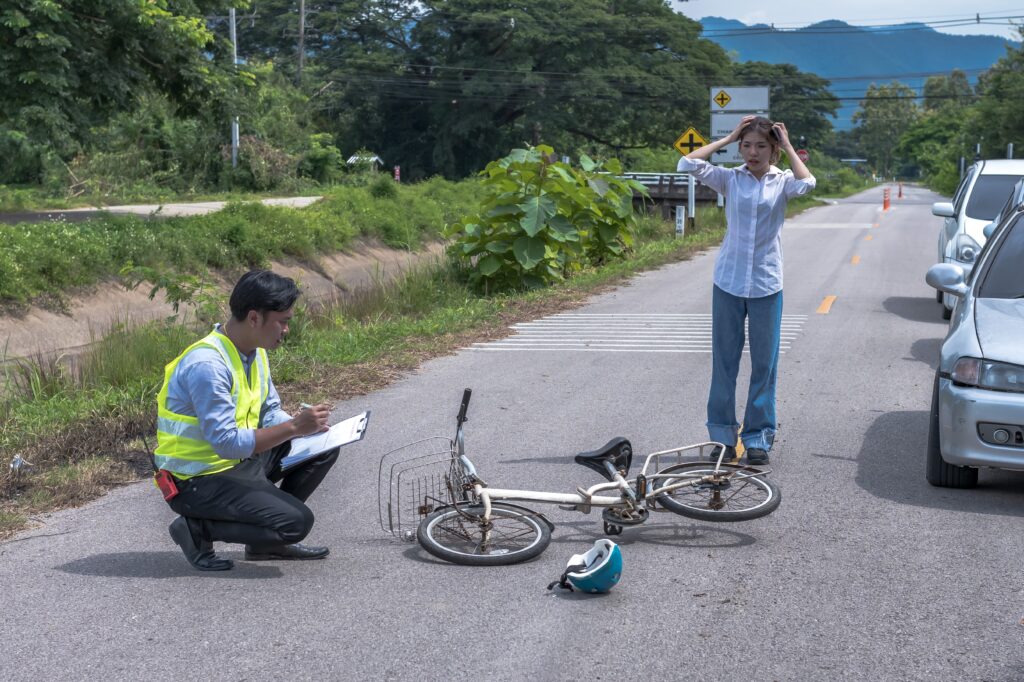In Alberta, cyclists under the age of 18 are required by law to wear a helmet, and helmet use for adults is strongly encouraged. These and other laws are designed to reduce the risk of head injuries in bicycle accidents. If a cyclist suffers an injury in a crash while not wearing a helmet, the insurance company may wrongfully try to shift blame, arguing that the lack of a helmet contributed to the severity of the injury. However, a Calgary bicycle accident lawyer can counter this argument by demonstrating that the primary cause of the accident was the driver’s negligence, not the cyclist’s helmet use. A lawyer can also show that the injury would likely have occurred regardless of whether a helmet was worn, protecting the cyclist’s right to full compensation.If you recently suffered injuries in a bicycle accident, a knowledgeable lawyer will examine the facts and circumstances, determine your legal options, and pursue the compensation and justice you deserve for your losses.
Most Common Helmet Laws in Alberta and How They Keep Bicyclists Safe in an Accident

Helmet laws in Alberta play a crucial role in promoting safety for bicycle riders. These regulations are designed to reduce the risk of head injuries, which are among the most severe consequences of bicycle crashes.
Helmet Requirements in Alberta
Under Alberta’s Traffic Safety Act, bicycle helmets are mandatory for all riders and passengers under the age of 18. This law applies whether a cyclist is riding on a public roadway, a bike path, or a sidewalk. Parents or guardians are responsible for ensuring that minors comply with the helmet law, and failure to do so may result in fines.
While helmet use is not legally required for adults 18 and older, it is strongly recommended. Helmets must meet specific safety standards, such as those set by organizations like the Canadian Standards Association (CSA) or the Consumer Product Safety Commission (CPSC). Helmets that meet these standards offer proven protection against head injuries.
How Helmets Protect Cyclists
Wearing a helmet significantly reduces the risk of serious head injuries in the event of a crash. Helmets are designed to absorb the impact of a collision, shielding the skull and brain from direct trauma. This is especially important in Alberta, where cycling accidents may occur due to interactions with motor vehicles – oftentimes over rough terrain.
Helmets also protect against facial injuries and traumatic brain injuries (TBIs), which can have long-term effects on memory, motor skills, and overall quality of life.
How Do Negligent Drivers Cause Bike Crashes?
Negligent drivers are one of the leading causes of bicycle accidents, often putting cyclists at serious risk of injury or death. Their careless actions can result in dangerous situations for everyone on the road. Here are the most common ways that negligent drivers cause bicycle accidents:
- Distracted Driving: Drivers who are texting, using their phones, eating, or engaging in other distractions often fail to notice cyclists. Taking their eyes off the road for even a few seconds can lead to a collision, especially when a bicycle is in their blind spot or nearby.
- Failing to Yield: Many drivers fail to yield the right-of-way to cyclists, particularly at intersections or when making turns. A common scenario occurs when a driver turns left or right without first checking for bicycles, resulting in a collision with a cyclist who has the right-of-way.
- Speeding: Excessive speed reduces a driver’s ability to stop in time to avoid hitting a cyclist. It also increases the severity of accidents, as the force of impact is much greater at higher speeds, leading to more serious injuries or fatalities for the cyclist.
- Unsafe Passing: Drivers often pass cyclists too closely, ignoring laws that require a safe distance between vehicles and bicycles. This can cause cyclists to lose balance or veer off the road. Some drivers may even clip cyclists while passing, leading to severe accidents.
- Running Stop Signs or Red Lights: When drivers fail to obey traffic signals, they create hazardous conditions for cyclists. A driver running a red light or stop sign can strike a cyclist crossing the intersection, often with catastrophic results.
- Opening Car Doors Without Looking: “Dooring” accidents occur when vehicle drivers or passengers open their car doors without checking for cyclists approaching from behind. Cyclists may crash into the door or swerve into traffic to avoid it, causing additional risks.
- Driving Under the Influence: Impaired drivers have slower reaction times, poor judgment, and reduced awareness, making it more likely they will collide with cyclists.
How do Helmet Laws Affect Bicycle Accident Claims?

In bicycle accident cases, insurance companies often try to shift blame onto the cyclist in an attempt to reduce their payout. One common tactic involves questioning whether the cyclist was wearing a helmet – especially if the injury is a head trauma. Insurance company adjusters may argue that failure to wear a helmet contributed to the severity of the injury, even if it was the motor vehicle driver’s negligence that caused the accident. Here’s how insurance companies use this tactic and how a skilled bike accident lawyer can fight back.
Blaming Lack of Helmet Use
Insurance companies may argue that the cyclist’s failure to wear a helmet directly contributed to the head injury, even if the injury would have occurred regardless of helmet use. While helmets are effective in reducing the severity of head injuries, they do not prevent accidents resulting from negligent drivers. By placing blame on the cyclist for not wearing a helmet, insurance companies hope to reduce their liability, making it seem like the cyclist’s own actions were partly responsible for their injuries.
Using Helmet Laws Against Cyclists
In places where helmet laws are in effect, insurance companies may attempt to use non-compliance with those laws as a way to reduce compensation. They may argue that because the cyclist was not wearing a helmet as required by law, the severity of the injury was heightened. While helmet laws are intended to protect cyclists, they should not serve as an excuse for a negligent driver’s behaviour – especially when the cause of the accident was the driver’s fault.
How a Lawyer Can Combat These Tactics
An experienced bicycle accident lawyer can counter these wrongful tactics. First, a lawyer will emphasize that even if a cyclist was not wearing a helmet, the driver’s negligence remains the primary cause of the accident. The cyclist’s not wearing a helmet does not excuse a driver’s reckless actions, such as speeding or distracted driving.
The lawyer can also point to expert testimony showing that while helmets are important, they do not fully prevent accidents or reduce injuries resulting from motor vehicles. They may also use medical records to demonstrate the severity of the injuries and the direct cause, further proving that the injury would have occurred regardless of helmet use.
Head Injuries that Bicyclists Can Suffer in an Accident Even While Wearing a Helmet
Even though wearing a helmet significantly reduces the risk of severe head injuries, bicyclists can still suffer serious trauma in an accident. Helmets are designed to absorb impact and protect the skull, but they cannot prevent all types of head injuries. Below are some common head injuries that bicyclists may experience, even when wearing a helmet:
Concussions
A concussion is one of the most common head injuries in bicycle accidents. It occurs when a blow to the head causes the brain to move inside the skull, leading to temporary disruption in brain function. Symptoms may include confusion, dizziness, headaches, memory loss, and nausea. While helmets reduce the force of impact, they cannot completely eliminate the risk of a concussion, especially in high-impact crashes.
Contusions (Bruises)
Contusions, or bruises, can occur when the brain collides with the inner surface of the skull. This can cause bleeding and swelling in the brain tissue. While helmets help prevent external injuries to the scalp, they don’t fully protect the brain from the impact force. Contusions can result in cognitive issues, dizziness, and long-term complications.
Skull Fractures
A skull fracture can occur even when a cyclist is wearing a helmet. If the force of the collision is severe enough, the helmet may not absorb all of the impact, resulting in a fractured skull. This type of injury can be extremely dangerous and may lead to brain damage or require surgery to repair.
Diffuse Axonal Injury (DAI)
Diffuse axonal injury occurs when the brain rapidly shifts inside the skull due to a sudden stop, such as during a high-speed bicycle crash. This injury can tear nerve fibres in the brain and lead to severe long-term effects, including unconsciousness, memory problems, and permanent cognitive impairments. Helmets can’t prevent the brain from moving violently inside the skull, which is why this injury can still occur even with a helmet.
Brain Hemorrhages

A brain hemorrhage, or internal bleeding in the brain, can occur when blood vessels are ruptured due to impact. This type of injury can lead to swelling and pressure on the brain, potentially causing brain damage, stroke, or death. Helmets may reduce the chance of skull fractures, but they do not eliminate the possibility of brain hemorrhages.
Damages You Can Recover for Head Injuries in a Bike Accident
When a bicycle accident results from a driver’s negligence and leads to head injuries, victims may be entitled to compensation to address the physical, emotional, and financial toll resulting from their injuries. Compensation can aid in a victim’s recovery and ensure that they are fairly compensated for their losses and suffering.
One of the most common types of recoverable damages is lost income. If the victim is unable to work due to their head injury, they may be entitled to recover the earnings they would have earned during their time off. Head injuries like concussions or more severe brain trauma can leave the victim unable to perform their job duties – sometimes for weeks or months. If the injury results in permanent disability, the victim may also be entitled to compensation for the long-term effects on their earning capacity.
Pain and suffering compensation addresses the physical pain and emotional distress that a victim endures due to their head injury. This includes both the immediate pain experienced after the accident as well as long-term pain from ongoing symptoms like headaches, dizziness, or cognitive difficulties. Emotional distress from the injury may also be included, such as anxiety, depression, or post-traumatic stress disorder (PTSD), particularly if the injury affects the victim’s quality of life.
A head injury can also reduce a person’s ability to enjoy activities they once did, such as biking, playing sports, or even socializing with friends. Compensation for loss of life enjoyment is intended to address the negative effects on the victim’s overall quality of life. This can include an inability to participate in hobbies, recreational activities, or family events that were once enjoyed.
Emotional distress compensation covers the mental toll resulting from the injury. Head injuries, particularly brain trauma, can lead to changes in personality, mood swings, memory problems, and difficulty with concentration. These emotional and cognitive effects can affect relationships with family, friends, and co-workers. Victims may experience frustration, embarrassment, or isolation, all of which are addressed through emotional distress compensation.
Finally, in cases where the driver’s actions were particularly reckless or grossly negligent, punitive damages may be awarded. These damages are not meant to compensate the victim but rather to punish the wrongdoer and deter others from similar behaviour. For example, if the driver was under the influence of alcohol or drugs or was engaging in extremely dangerous driving behaviour, the court may award punitive damages to reflect the severity of their misconduct.
An experienced lawyer will pursue all available compensation so that the bike accident victim can fully recover from the financial and emotional consequences of their injury.

Talk with a Skilled Bicycle Accident Lawyer Today
If you suffered injuries in a bicycle crash resulting from a negligent driver, a knowledgeable lawyer can investigate your accident circumstances, handle the steps of filing a claim or lawsuit on your behalf, and pursue the compensation you need. Contact an experienced Calgary personal injury lawyer about your case right away.
